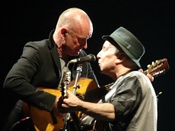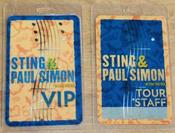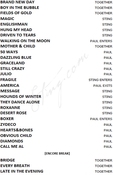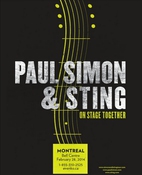
Paul Simon and Sting: On Stage Together
Paul Simon and Sting at the Bell Centre...
There's really no obvious reason the Simon and Sumner partnership should have worked.
Unlike the highly logical tour teaming of, let's say, Elton John and Billy Joel, Paul Simon and Sting seem to share little in common. At least on paper.
Simon, 72, one of the rock era's most important singer-songwriters, had already recorded a virtually flawless oeuvre with Art Garfunkel and released most of his essential solo work before Sting, 10 years younger, entered our consciousness as a New Wave rocker with the Police in 1978. Little of the erstwhile Gordon Sumner's catalogue is what one might expect Simon to wrap his own poetic sensibilities around.
Nor was it easy to imagine much of an overlap between the fan bases of the two artists.
And sure enough, in their joint concert at the Bell Centre Friday night, some juxtapositions seemed uncomfortable, to be sure. Following up the epochal drama of Bridge Over Troubled Water with the stalker-rocker Every Breath You Take, for example, was undeniably jarring.
And yet such was the intensity of the mutual admiration society the two musicians seem to have formed that their two-hour-and-40-minute concert felt like it could go on all night - and that, indeed, it would and, most impressively, should. The sight of the two sharing a hug and some laughs at the end of the night (how often have you seen Paul do that with Artie in recent years?) spoke volumes.
While their respective latest albums - Simon's So Beautiful or So What (2011) and Sting's The Last Ship, from last year - rank among their strongest solo work, only one song from Simon's disc, Dazzling Blue, made the set list.
Instead, they focused on some of their most recognizable songs, with a few deep-catalogue delights, like Simon's Hearts and Bones and That Was Your Mother, added for good measure. While covering every key song by both performers would have kept the audience in the arena until about lunchtime Saturday, the insightfully-planned setlist managed to create the impression that little was missed.
It was a magical night, with virtually no missteps. The songs were beautifully chosen and performed, with help from an astonishing group of 14 musicians from both Simon's and Sting's bands, in various combinations. The exquisite chops demonstrated on stage helped drive the material home, while making it seem truly alive. There was no sense of the all-too-common and often forced jukebox fidelity one hears from so many veteran artists these days.
Sting faced the biggest challenge, having to blend his voice with Simon's and, in a couple of cases, make people forget the angelic beauty of Garfunkel's contribution to the original records. And while the quality of Sting's voice is very different from Garfunkel's, he managed to chart his own trajectory on the high harmony of The Boxer and walk away without a scratch from America - which he sang alone, with Simon off stage - and even the daunting Bridge.
On his own deliriously-received hits, like Roxanne, An Englishman In New York and Message in a Bottle, Sting proved himself to be in fine voice, hitting the high notes full on and gamely leading the crowd in the de rigueur “ee-yoh” singalongs.
All Simon had to do to leave the audience satisfied was pretty much show up. But he went the extra mile, stretching out on songs like the ever-irresistible You Can Call Me Al, a relentlessly building Graceland and the impossibly-joyous Diamonds On the Soles of Her Shoes.
On Me and Julio Down By the Schoolyard, the band swung like mad while Simon gestured wildly, shaking his hips and generally seeming to have a whale of a time. He even took the lead vocal on the Sting song Fragile, while the two traded verses - as they did several times during the evening - on Fields of Gold, which has a melancholic traditional-folk melody that suits Simon's voice perfectly.
When Simon released Still Crazy After All These Years, he was 34. Close to 40 years later, he still sings it, with more conviction added by all the extra years since then. But he's crazy like a fox - and the audience, who cheered the song's overall sentiment and sang along with palpable warmth, knows that. And they still love him for it.
(c) The Montreal Gazette by Bernard Perusse
Sting and Paul Simon at the Bell Centre: Two legends reunited...
Attending a living legend's concert is impressive enough. But seeing two of them together on stage is enough to make your feet tap. This is the kind of evening the audience at the Bell Centre experienced Friday night, as Sting and Paul Simon shared the amphitheatre's stage.
A little background: the two singers live in the same building in New York City. Passing him in the stairwell, Paul Simon shared his idea with Sting about the idea of touring together. The popular English singer immediately accepted the invitation from the man he discovered as a teenager during the Simon & Garfunkel era.
Friday night, to kick off the festivities, Sting grabbed his bass, Paul Simon his guitar, performing the catchy "Brand New Day." One song was all it took for the duo to bring the audience to their feet.
"Good evening everyone! Hello my friends!" Paul Simon called out to the crowd in French, prompting a round of applause. "Welcome to our two worlds merged. Two different bands and two different repertoires combined," he added before calling out to a female spectator in the audience and joking with Sting. The Bell Centre suddenly felt almost intimate.
The two rock stars had promised to perform their greatest hits, and that's exactly what they did, belting out classics from their personal and group repertoires (solo or duo). Indeed, Sting offered songs by his old band, The Police, while Paul Simon performed songs from his days as a duo with Arthur Garfunkel.
From the first notes of each song (or almost), the audience screamed in the stands, like children discovering the contents of a goody bag. "Fields of Gold" made an impression, as did "Every Little Thing She Does is Magic," which Sting performed solo (with his dozen musicians).
The same thing happened when Paul Simon performed "50 Ways to Leave Your Lover": people clapped enthusiastically. For Dazzling Blue, while the blue lights were dimmed, you could feel the audience captivated, attentive to the slightest guitar strum, to the slightest note of this folk-rock ballad. Pure listening pleasure.
It was for Message in a Bottle that the enthusiasm of the packed Bell Centre reached its peak, as Sting sat alone at the microphone, while Paul Simon enjoyed his moment of fame with Julio, a soaring horn and guitar riff. For The Boxer, the chorus's "Lie la lie" echoed through the room.
Still, even though the two performers were impeccable solos, we would have liked more duets. Because it was when they were together on stage that the magic really happened. At the encore, when the new partners joined forces to perform "Bridge Over Troubled Water," we grasped the full potential of this temporary professional union.
Sting and Paul Simon kicked off their tour on February 8th in Houston, Texas. Their "union" is therefore very recent. And it's evident in the almost feverish pleasure they seem to have together on stage!
(c) Le Journal du Montreal by Judith Plamondon
Paul Simon & Sting at the Bell Centre: Double Dose...
Two giants of pop music, Sting and Paul Simon, have found a balance together, offering a panoply of their hits composed over the past decades. On one side, English elegance and slenderness, and on the other, American bonhomie and casualness. Halfway through, a refined 150-minute concert delivered at the Bell Centre in Montreal on Friday evening.
A rather surprising project, this show was born from a proposal made to Sting by Simon, one of his days in New York: to go on tour together. The idea, simple in theory, could have led to disappointing results on stage. It's not easy to create a concert that respects both the fans and the work of two living monsters of music who suddenly decide to jump on the same stage to share their mutual works.
That said, it was worth the effort.
Sting (62) and Simon (72) opened the evening side by side to perform the songs Brand New Day, Boy In Bubble and Fields of Gold.
Next, it was Sting's turn (with his bass) to perform, among other things, "Every Little Thing She Does Is Magic" (a song by his former band The Police) and "Englishman in New York," in a relatively faithful format featuring the clarinet, to which the band added trumpet and saxophone. Also performed were "I Hung My Head," "Driven to Tears," and "Walking on the Moon," the latter with a touch of reggae and enhanced by beautiful rock arrangements, in keeping with the spirit of the old English band.
You guessed it, Paul Simon arrived later with his guitar to offer his own songs. But first, to create a more seductive transition, Sting and Simon sang together "Mother and Child Reunion," written by the American. Without ceremony, Sting handed the stage over to his partner while he performed 50 Ways to Leave Your Lover (groovy, jazzy, and fun; the audience loved it), Dazzling Blue (very subdued), and the famous Graceland, carried by a rock-country vibe that evoked a perfect trip to the States.
It's no surprise then that each artist brings their own band of musicians, who end up playing together for a few songs, when the mood allows.
About ten minutes later, Fragile (written by Sting) was superbly presented by the two men, the Brit's voice (usually more attacking than his partner) blending wonderfully with Simon's. Another pleasant transition.
Still with an acoustic guitar around his neck, Sting delicately sang Kathy's Song (by the very popular duo Simon and Garfunkel). Later, the very rocking Message in a Bottle (a highlight) thrilled the audience. The immortal Roxanne (another of The Police) then arrived in a refreshed outfit: the Montrealers were completely charmed. Clearly, these two songs are still as effective as ever. The same goes for the next piece, The Boxer (another Simon and Garfunkel), performed as a duet. Excellent silky folk-country spiced with Mexican trumpet melodies.
Simon continued with Hearts and Bones (a sweet guitar party that once again confirmed the musicians' talent), That Was Your Mother, Diamonds on the Soles of Her Shoes and You Can Call Me Al. It was especially during this period of the show that we felt that Simon's music, very folk-rock'n'roll-R'n'B, had also made room for African, Jamaican and Louisiana influences throughout his career.
The encore featured "Bridge Over Troubled Water," in which Sting offered a sensitive reinterpretation (what a voice, really) of Garfunkel's part.
As for Simon, who was also at the mic at the time, we couldn't help but appreciate his immense talent as a melodist. For the other two pieces (Every Breath You Take and Late in the Evening), the two men repeated the duet format.
Just before the curtain fell, they sang—with acoustic guitars only—the brilliant and relaxed "When Will I Be Loved?" by The Everly Brothers, one of the concert's highlights.
Despite the fact that this tour only began at the beginning of February, the overall performance was almost impeccable. The dozen musicians, as well as the very talented backing singer, did a solid job, while having a blast.
Despite the fact that Sting and Simon might initially seem to have little in common, aside from the vastness of their repertoire, the two giants give the impression of a perfect fit. They share a passion for music, perhaps a similar creative instinct. In short, our fears were allayed after the first third of the concert: we fortunately felt the complicity essential to this kind of production.
A few jokes and well-prepared lines, yes, and a few gestures of discomfort too, nonetheless contribute to constructing a universe through which we enjoy traveling. Another positive aspect of this show, which features more than thirty songs, is that several old classics are enlivened with sophisticated and brilliant arrangements that create beautiful bridges between the past and the present.
Overall, the veterans put on a very good show.
(c) Le Huffington Post Québec by Jean-François Cyr
Paul Simon and Sting - When one and one make thirty...
Sting and Paul Simon performed a joint show at the Bell Centre Friday night.
Paul Simon and Sting? The kid from Queen's and the "English" prince? Together? Singing together? Really? Yes, right from "Brand New Day-Boy In The Bubble-Fields Of Gold," the opening salvo of their joint show at the Bell Centre Friday night, it happened: they sang together. And in harmony, no less, like Paulie and Artie. All that was missing was a curly wig on Sting's bare head. I admit: until then, I didn't believe it: at least, I didn't believe that these two artists, certainly major but very distinct in the history of popular music, would offer anything other than a double bill, just to double the attendance and revenue.
The question, in fact, arose when the tour was announced, so to speak, brought on the proverbial silver platter: what the hell were these two guys going to do on the same stage, if not find the right solution to a simple problem, namely that neither of them can fill a Bell Centre anymore? What did they have in common, if not solo careers after glorious years as a folk-pop duo, or a rock-reggae trio?
It quickly became clear on Friday: they both have a hefty collection of well-known songs. Enough hits to equip the plumbing of a hydroelectric power plant. Two catalogues whose depth recalls the arrival of Simpson's and Eaton's on the same day for New Year's gifts. Thirty songs were on the program; who could have had a hundred?
Sting, in his first solo segment of the show, seamlessly played both Police and non-Police hits, all unstoppable hits: Every Little Thing She Does Is Magic, Englishman In New York, Driven To Tears, and Walking On The Moon. Paul Simon, in his first tour, didn't have to search long to find a winning set: 50 Ways To Leave Your Lover, Graceland, Still Crazy After All These Years, and Me And Julio Down By The Schoolyard. Each had a less obvious song in the mix: I Hung My Head for Sting, Dazzling Blue for Simon. Almost unnoticed, but rather pretty and beautifully played, and above all, they gave a measure of the depth of the pews.
I still don't know how much they appreciate each other, even though they duly paid tribute to each other: of course, Simon couldn't believe he had the chance to sing Sting's Fragile (with Sting on classical guitar), and Sting didn't fail to declare—in French—that Simon was "a master of song." Very good. Let's have no doubt about it.
The fact is, they truly took advantage of the opportunity to play in each other's backyard, and that made the occasion truly unique: Sting particularly distinguished himself with his version of Simon & Garfunkel's America, as Simon did in Fragile. Sharing The Boxer was riskier, and less successful: not everyone can be Art Garfunkel, and Sting's harmonies—although in great voice on Friday—had neither the delicacy nor the incredible instinct of Simon's old friend.
I would add: they made a strange pairing, these fellows whom life, a priori, had no intention of bringing together (in this genre, there are points of comparison: let's mention the very fine George Harrison-Paul Simon duet on Homeward Bound during Saturday Night Live, and similarly Sting-Springsteen's Every Breath You Take during the Human Rights Now! tour). Today's Sting may be flexing his biceps in his tight-fitting sweater, but his veins are slack, and Simon is looking more and more like Mel Brooks in To Be Or Not To Be. Next to each other? Very foreign bodies. And increasingly foreign to themselves.
That said, musically, with fourteen players around, things were smooth sailing, especially in the percussion, which was the glue that bound these very different works together: thus, we moved naturally from Walking On The Moon to Mother And Child Reunion, variations of swaying rhythms. That said, in the party's charts, poor Simon may have struggled with his Julio or You Can Call Me Al, but he never generated as much reaction as Sting with his Message In A Bottle or Roxanne. This Bell Centre audience was still primarily the British artist's: it's at Wilfrid that we would go to see Paul Simon (as at the FIJM a few years ago).
With almost three hours of expertly played versions, fans of both were certainly satisfied, and the shared portion was not stingy: no one will complain. I still came away with the impression that none of it had been very emotional, and that the promised "experience" of the improbable meeting of the two worlds had only taken place on the surface of things. Go watch any clip of the Police, or Simon with Garfunkel marrying their timbres in Old Friends, and the evidence hits you: all the professionalism in the world, and the obvious talent of great artists, do not lead to the natural chemistry of beings.
(c) Le Devoir by Sylvain Cormier
Sting and Paul Simon: the two make a great pair...
Simon and Stingfunkel. The joke came from Sting's mouth one evening in May 2013, during a benefit gala where the Briton sang two songs with his American friend Paul Simon. It was that evening that the two former neighbours from Manhattan's Upper East Side first came up with the idea of continuing their adventure together for a show. The key word being "together," as surprising as this marriage may seem between these two very different men, born on opposite sides of the Atlantic ten years apart.
Last night, the approximately 11,000 spectators who gathered at the Bell Centre were treated to a generous concert, a nearly three-hour affair during which each of the two singers dipped into their vast repertoire of songs. Most of the time, very familiar songs, with the exception of the more recent Dazzling Blue, which is very subtle and which Simon had the good idea to sing. It was also the American who wanted to pay tribute to those who came before him and left their mark on him: Junior Parker and Elvis (Mystery Train), Chet Atkins (Wheels) and, at the very end of the evening, When Will I Be Loved, which Sting and he sang alone on stage as a tip of the hat to the Everly Brothers.
Each of the two men performed their own compositions separately, Sting's compositions being fairly faithful to the versions he's performed during his many visits to Montreal. The audience, which was firmly rooted in his legacy, was eager to hear his greatest hits, with or without The Police.
Since Simon was less present - this was his fourth appearance in 28 years in Montreal - we were able to enjoy some of his refreshed classics, such as the ever-relevant "Still Crazy After All These Years" and the catchy "Me and Julio Down By the Schoolyard," as well as the wide range of musical styles he brought to his songs, from folk to zydeco, including South African and even Indian rhythms and colours. As the evening progressed, Simon received more and more acclaim, culminating in the well-deserved standing ovation that followed "You Can Call Me Al."
But this no-nonsense, music-driven show truly took on its full meaning when Sting and Paul Simon sang together for about a third of the show, starting with "Brand New Day" and then continuing with "Boy in the Bubble" and "Fields of Gold."
Later, it was the American who covered "Fragile" and the Briton, "America." These borrowed songs spoke more of the admiration they share for each other than the sincere compliments and bows they exchanged.
This complicity, this deep respect, was just as palpable among the two artists' army of musicians, who played in varying configurations depending on the songs' needs.
Despite his joke, Sting didn't try to make us forget Art Garfunkel. But when he sang with Simon The Boxer and then launched into "Bridge Over Troubled Water" with a piano background, the Englishman with the golden voice performed so well that an immense thrill of happiness ran through the stadium.
(c) La Presse by Alain de Repentigny










